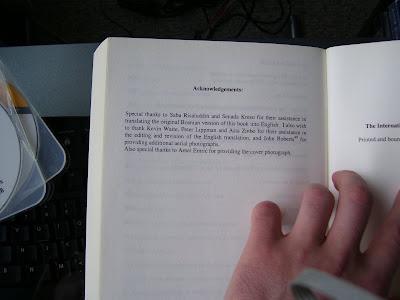HOME LIBRARY OF GENOCIDE RESEARCH

Click photo for Full Size.
I received this book from Prof. Besim Ibisevic as a sign of support for my Srebrenica activism. Prof. Ibisevic is a local historian and a former mayor of Srebrenica. This book is the ultimate pre-genocide educational source, and it is absolutely a 'must-read' for anyone who wishes to gain a more broad understanding of the events preceding the 1995 Srebrenica Genocide. In this book, you will learn the inside knowledge about Serbia's secret police training and arming the Serbs in the area long before the war started. You will also gain in-depth knowledge about Srebrenica's key political figures, including controversial Ibran Mustafic. Unfortunately, the book is available only in Bosnian language (as far as I know!) and was extensively used as evidence by the Hague Tribunal and the Netherlands Institute for War Documentation (NIOD). Let's open the book now:

On the II page (see photo above), Prof. Ibisevic's wrote the following:Click photo for Full Size.
"I dedicate this book to the Bosniaks of Srebrenica, victims of the Serbian barbarism. We cannot change the world in which we live! But, we can and we must change ourselves!, so tragic experience from the recent past never repeat themselves!..."
#2. "The United Nations on the Srebrenica's Pillar of Shame" by WOMEN OF SREBRENICA [Bosnian / English ] ↓
Click photo for Full Size.
I received this book from Hajra Catic, head of the NGO Women of Srebrenica, thanking me for my support of their cause. If you're looking for the ultimate research on the war time Srebrenica (from 1992 up to July 1995) with the emphasis on the role of the United Nations (Dutchbat), then this book will blow your mind. It details 104 testimonies about the role of the U.N. in genocide against the population of the U.N. "Srebrenica Safe Haven." The book also clarifies demilitarization agreements that were constantly violated by the Bosnian Serb Army! You will also learn how Serbs targeted civilians in the besieged Srebrenica with snipers, artillery, even with airplanes! This book is absolutely awesome and is available in both Bosnian and English language. Take a look at some of the pages in this book:
Click photo for Full Size.

Click photo for Full Size.
Here is another page describing how Serb sniper targeted Bosniak woman Aisa Salkic with a one year old son in her lap in May 1994: ↓

#3. "Under the UN Flag" by HASAN NUHANOVIĆ [English / Bosnian ] ↓Click photo for Full Size.

I received this book from Hasan Nuhanovic as a gift. It's in English language. The book brings unique perspective from a man who worked for the United Nations and who lost his family in the Genocide. When Hasan was writing this book, I offered to do a sample cover design, and once I finished, he kindly rejected it. Here is my version of the concept: ↓
Click photo for Full Size.
You won't see my name in the credits on the last page. I kinda felt it should be nice if my name was included, because it took me a long time to come up with a good concept which was not accepted... ouch! But it's okay :) ↓
Click photo for Full Size.
As a survivor of the Srebrenica Genocide, Hasan Nuhanovic warns in the Foreword of his book that "the book book you are now holding in your hands is an important publication!" And he is correct. ↓

#4. "Historija Bosnjaka" (History of Bosniaks) by MUSTAFA IMAMOVIĆ [Bosnian] ↓Click photo for Full Size.

Click photo for Full Size.
This book details the history of Bosniaks from the middle ages up until the Bosnian war of the 1990s. There are some things I disagree with in this book, but the overall quality of the research is very good. Unfortunately, the book is available only in Bosnian language. When you open the book, you will see historic map of our country - it was much bigger than today! Take a look:

Click photo for Full Size.
#5. "The Works in Logic in Arabic by Bosniak Authors" (Logička Djela Bošnjaka na Arapskom Jeziku) by AMIR LJUBOVIĆ [ Bosnian ] ↓:

Click photo for Full Size.
This is a very rare book. I ordered it few years ago from Interliber.ba (online Bosnian book store located in Sarajevo). The book was printed in only 700 copies and published by the ORIENTAL INSTITUTE in Sarajevo. In 1992, Bosnian Serbs attempted to erase the Bosniak history by shelling and burning the Oriental Institute. The entire library of rare manuscripts and books was burned to the ground. This book practically came from the ashes, as people of Sarajevo managed to save some pages of history. The book details key contribution of the Bosniak people to Philosophy/Logic in Arabic language. Although the book contains one chapter in English, the rest is written in Bosnian language. ↓
Click photo for Full Size.
#6. And finally, I am very happy for offering the research assistance to BBC NEWSNIGHT "The Land that Radovan Built" in September 2008. This half-hour documentary details the legacy of Radovan Karadzic - torutre, ethnic cleansing, genocide, and fear felt among the Bosniak returnees to Republika Srpska: ↓
BBC Producers sent me a Thank You note, take a look ↓Click photo for Full Size.

Click photo for Full Size.
That's all. I hope you enjoyed it. It took me a long time to organize this post. If you have any feedback, go ahead, drop it in the comment box below. Thank you for reading :)




<< Home